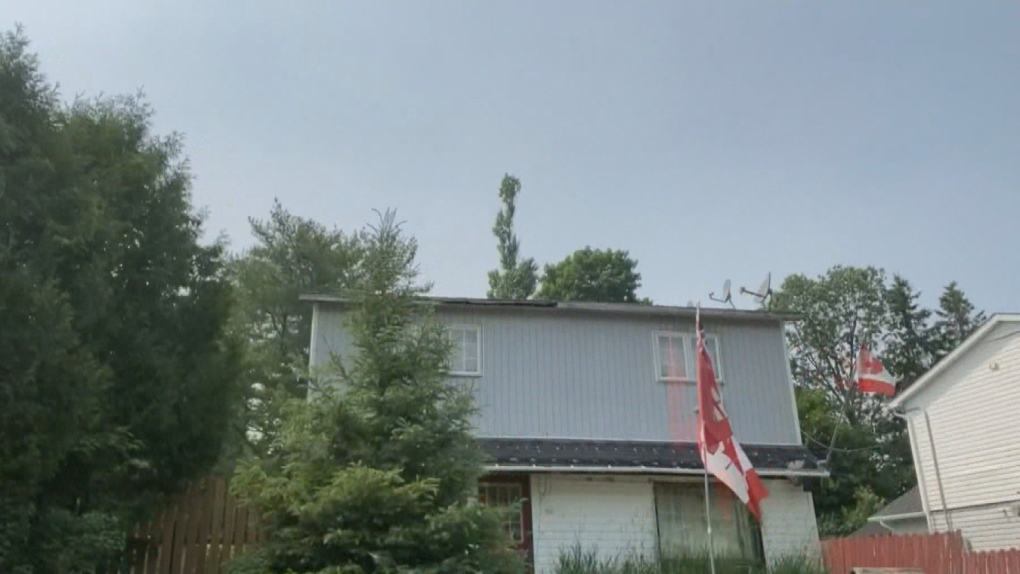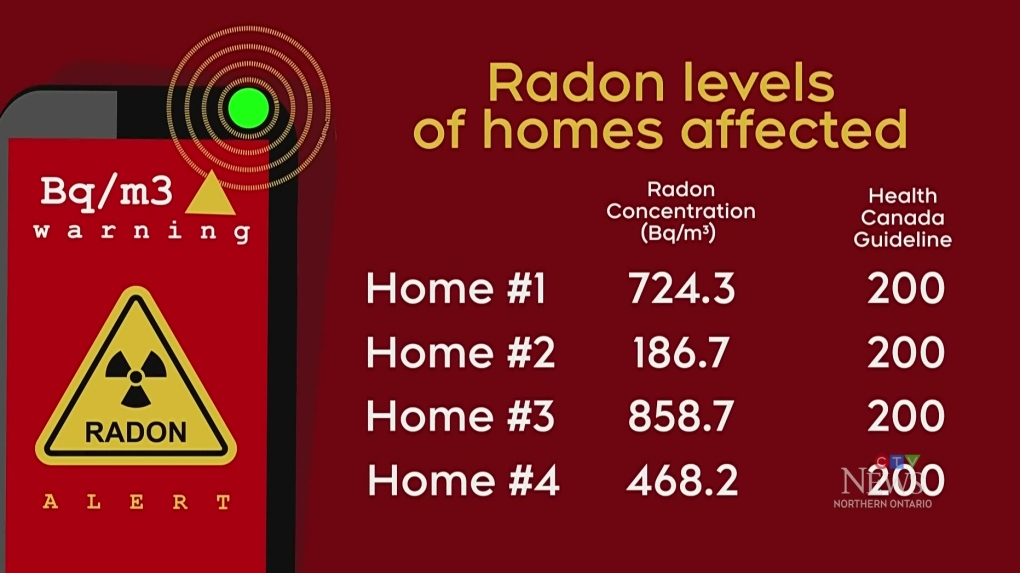Lawyers spar over what constitutes nuclear mine waste in Elliot Lake, Ont.
A federal court hearing Wednesday saw lawyers for Elliot Lake homeowners and the Attorney General of Canada argue over the definition of nuclear mine waste.
At issue are high levels of radon found in three homes in Elliot Lake, Ont., levels that far exceed safety guidelines for human health.
 One Elliot Lake property tested positive for radon with a level of 858.7 Bq/m³. To put that in perspective, Health Canada's guideline for radon exposure is only 200 Bq/m³. (File photo/Ian Campbell/CTV News Northern Ontario)
One Elliot Lake property tested positive for radon with a level of 858.7 Bq/m³. To put that in perspective, Health Canada's guideline for radon exposure is only 200 Bq/m³. (File photo/Ian Campbell/CTV News Northern Ontario)
One resident involved in the case, Jennifer Carling, and her husband bought a house in the community and relocated from Toronto, Ont.
The couple was aware that naturally occurring radon levels were higher in Elliot Lake, which used to be home to a uranium mine.
But they were shocked when they had their property tested and it came back with a reading of 858.7 Becquerels per cubic metre, which is a measure of radioactivity.
Health Canada's guideline for radon exposure is only 200 Bq/m³. Another home involved in the case tested at 724.3 and another at 468.2.
 High levels of radon were found in three homes in Elliot Lake, Ont., levels that far exceed safety guidelines for human health. Health Canada's guideline for radon exposure is only 200 Bq/m³. (File photo/Image from video report/CTV News Northern Ontario)
High levels of radon were found in three homes in Elliot Lake, Ont., levels that far exceed safety guidelines for human health. Health Canada's guideline for radon exposure is only 200 Bq/m³. (File photo/Image from video report/CTV News Northern Ontario)
The homeowners appealed to the Canada Nuclear Safety Commission (CNSC) to inspect their homes and order BHP, which now owns the former Rio Aglom mine, to remove the waste rock.
What isn’t in dispute is that the source of the radiation is rock waste from the former uranium mine that was used in the driveways and crawl spaces of the homes.
But in a June 2023 letter, the CNSC insisted that the rock was not mine waste under its definition, and therefore beyond its jurisdiction.
That’s because the rock used in the homes was separated from the ore and discarded before the uranium was processed.
The Canadian Environmental Law Association is appealing the CNSC’s decision on the homeowners’ behalf.
Lawyer Jacqueline Wilson told Federal Court Justice Ann Marie McDonald on Wednesday that the main purposes of the CNSC is to protect Canadians from the effects of mining nuclear material.
But now Wilson said the organization is trying to argue that rock taken from the mine site and dumped somewhere else is not their problem.
Such an interpretation would “undermine” the purpose of protecting the public from nuclear mine waste, she said.
'Perverse incentive'
Worse, it amounts to a “perverse incentive” for mining companies to move waste rock off-site to avoid regulations.
“The definition of mineralized waste rock says it has the potential to release substances that could jeopardize human health,” Wilsons said.
“The CNSC regulates mine waste rock at mine site, (but now it) argues its jurisdiction ends when mine waste is moved somewhere else.”
She said legislation prohibits companies from abandoning nuclear material. Since the waste rock used in the homes is considered nuclear material, it is under the CNSC’s jurisdiction and they should inspect the homes and order its removal.
But James Schneider, lawyer for the Federal Attorney General, told Justice McDonald that the CNSC’s decision is not reviewable.
But even if it was, Schneider said its jurisdiction does not include the type of waste rock used in the homes.
“It’s not associated with the production of nuclear energy,” he said.
“Not all uranium is a nuclear substance for this purpose.”
Must go through mining process
The CNSC is responsible only for rock waste that actually goes through the mining process, he said. Rock that hasn't been processed is considered to be in its natural state, and radon levels in natural rock are beyond their control.
“You’re not suggesting if there is nuclear material off-site of a mine, that it’s beyond regulatory authority?” McDonald asked.
“Expert reports say these rocks produce things that would fall within the nuclear substance definition.”
Schneider responded that if they were talking about something like mine tailings, it would be a different story.
“The CNSC’s position is that waste rock is not within the definition of a nuclear substance, even though it contains uranium,” he said.
“Rock that doesn’t enter the nuclear fuel cycle” and isn’t processed at the mine is not under the organization’s jurisdiction," he repeated.
Schneider said there are other organizations the homeowners can turn to, such as Health Canada and the Province of Ontario, which also regulate radon levels.
- Download our app to get local alerts on your device
- Get the latest local updates right to your inbox
“The province is regulating (radon levels) there now” in Elliot Lake, he said.
Alternates to rock removal are the use of radon fans, which Schneider said “were found to be effective.”
“(But) these are steps the applicants would have to take themselves, on their own dime?” McDonald asked.
“Yes, your point is correct,” Schneider said.
The hearing resumes Thursday morning at 9:30.
CTVNews.ca Top Stories

BREAKING 'Canadians deserve a real choice': Justin Trudeau resigning, prorogues Parliament
Prime Minister Justin Trudeau is stepping down as Liberal leader, and is proroguing Parliament as the Liberal Party of Canada embarks on the journey to replace him.
WATCH LIVE Justin Trudeau resigns as Liberal leader: Follow live updates
Prime Minister Justin Trudeau has stepped down as Liberal leader. Follow along for live updates from CTVNews.ca.
'Together, what a great nation it would be': Donald Trump, Elon Musk react to Justin Trudeau's resignation
Amid news of Prime Minister Justin Trudeau's resignation as leader of the Liberal party on Monday morning, reactions from prominent figures began piling in.
Justin Trudeau is resigning, what will be his legacy? A look back at key political eras
In a seismic political move, Justin Trudeau has announced his intention to step down as leader of the Liberal Party of Canada and prime minister, once his successor is named. This decision comes after more than nine years in the country's top job and nearly 12 years at the helm of his party.
Justin Trudeau resignation: Here's what he said in Ottawa today
Prime Minister Justin Trudeau delivered a speech about his political future Monday morning outside Rideau Cottage in Ottawa. Here's the message he delivered to Canadians.
Alberta government signs new oil and gas agreement with Enbridge
The Alberta government has signed an agreement with Enbridge that Premier Danielle Smith says will increase exports of the province's heavy oil to the United States.
Judge condemns murder trial delay, asks lawyers to 'turn around' and look at the public 'we serve'
A Saskatoon murder trial opened on Monday with the judge sharply criticizing the time it’s taken to get to trial.
Doug Ford snaps back at Donald Trump's Canada taunts with offer to 'buy Alaska'
Ontario Premier Doug Ford has snapped back at Donald Trump’s frequent taunts about treating Canada as a U.S. state with a counterproposal: buying Alaska.
Canadian alleged drug lord Ryan Wedding still has access to 'network of hitmen': U.S. prosecutors
U.S. prosecutors are seeking additional protections to keep the identities of confidential informants and co-operating witnesses hidden in the case against Ryan James Wedding, as the search continues for the Canadian ex-Olympian and alleged drug lord.

























